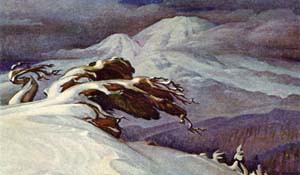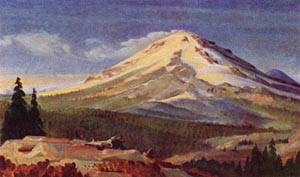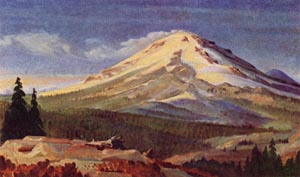While the fact is not widely appreciated, the existing remnant of old Mount Mazama affords an excellent field for the study of glacial erosion.
 The Volcano smolders beneath it’s icy cover, painting by Eugene Kingman, 1930s. |

Glaciers were born on the slopes of the Volcano, painting by Eugene Kingman, 1930s. |
The glaciers reached their maximum size some 25,000 years ago at the end of the Pleistocene Epoch, obtaining a depth of 1,000 feet and extending 10 to 17 miles from the summit.
During the final retreat, when the glaciers were confined to the canyon bottoms of the upper slopes, a semicircular line of parasitic volcanoes developed on the northern slope of the mountain, about 5,000 feet below the summit, what is now the rim of caldera.[Crater Lake National Park General Management Plan, December 1977, Part 2, pp. 2, 4]
Nature Notes From Crater Lake
- A Return Of The Ice Ages – Franklin C. Potter, Vol. 16 – 1950
- Three Successive Records Of Glaciation – E. L. Clark, Vol. 6 No. 3 – August 1933
- Glaciation of Mount Mazama – Dr. W. R. Atwood, Vol. 4 No. 3 – September 1931
- A Glaciated Surface – F. Lyle Wynd, Vol. 3 No. 2 – August 1930
- Carbonized Tree Found Within The Rim – D. S. Libbey, Vol. 6 No. 3 – August 1933
- Llao Rock, A Lava Flow Burying A Glacial Valley – Wayne E. Kartchner, Vol. 10, No. 3, 1937
- The Retreat Of Mount Mazama Glaciers – William Kinsley, Vol. 14, 1948
- Nivation – Franklin C. Potter, Vol. 15 – September 1949
Other pages in this section
*** previous title *** --- *** next title ***


